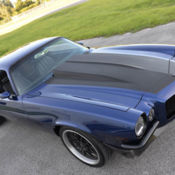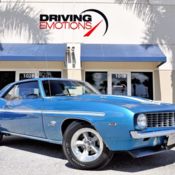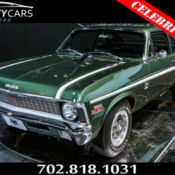On Mar-29-15 at 19:10:22 PDT. seller added the following information:1970 camaro Nice car with Go Fast Parts. The car has a 454ci bored out to a 468ci. edelbrock intake. holley carburetor and a comp 292 cam. Also a turbo 400 with 2500 stall converter with trans-brake. 12 bolt rear with 373 gears. The interior is clean with new headliner. The gauge cluster is not working. The paint is nice with some blemishes. Most of the engine and drivetrain components were carried over from 1969. with the exception of the 230 cu in (3. 8 L) six-cylinder — the base engine was now the 250 cu in (4. 1 L) six. rated at 155 hp (116 kW). The 1970 Camaro SS 396 had the 396 cu in (6. 5 L) L78 rated at 350 hp (261 kW). Starting in 1970. the big block V8s (nominally 396 cu in (6. 5 L)) actually displaced 402 cu in (6. 6 L). yet Chevrolet chose to retain the 396 badges. Two 454 cu in (7. 4 L) engines (the LS6 and LS7) were listed on early specification sheets and in some sales brochures but never made it into production. [3]Besides the base model. buyers could select the Rally Sport option with a distinctive nose and bumper. a Super Sport package. and the Z-28 Special Performance Package (priced at US$572. 95)[1]featuring a new high-performance LT-1 360 hp (268 kW) 380 lb·ft (520 N·m) of torque 350 cu in (5. 7 L) V8. The LT-1. an engine built from the ground up using premium parts and components. was a much better performer overall than the previous 302 cu in (4. 9 L) V8s used in 1967-69 Z-28s; greater torque and less-radical cam. coupled with the 780 cfm Holley four-barrel. 1] permitted the Z-28 to be available with the 3-speed[1] Turbo Hydramatic 400 automatic transmission as an option to the four-speed manual for the first time. The LT-1 engine in the 1970 Camaro Z-28 came from the Corvette. The new body style featured a fastback roofline and ventless full-door glass with no rear side quarter windows. Doors were wider to permit easier access to the rear seat. and new pull-up handles replaced the old handles. for which the lower button had to be pushed in to open the door. The roof was a new double-shell unit for improved rollover protection and noise reduction. The base model featured a separate bumper/grille design with parking lights under the bumper. while the Rally Sport option included a distinctive grille surrounded by a flexible Endura material along with round parking lights beside the headlights and bumperettes surrounding on both sides of the grille. The rear was highlighted by four round taillights similar to the Corvette. A convertible was not offered. making this the only Camaro generation not to offer one. [4] The '70½ was the first Camaro offered with a rear stabilizer bar. The four-wheel disc brake option (RPO JL8 of 1969) was dropped. [1] Inside. a new curved instrument panel featured several round dials for gauges and other switches directly in front of the driver while the lower section included the heating/air conditioning controls to the driver's left and radio. cigarette lighter and ashtray in the center and glovebox door on the right. New Strato bucket seats. unique to 1970 models. featured squared-off seatbacks and adjustable headrests. and the rear seating consisted of two bucket cushions and a bench seat back due to the higher transmission tunnel. The optional center console. with standard Hurst shifter. 1] was now integrated into the lower dashboard with small storage area or optional stereo tape player. The standard interior featured all-vinyl upholstery and a matte black dashboard finish. while an optional custom interior came with upgraded cloth or vinyl upholstery and woodgrain trim on dash and console. The 1970 model was introduced in February 1970. halfway through the model year. This caused some people to refer to it as a "1970½. " model; all were 1970 models. The 1970 model year vehicles are generally regarded as the most desirable of the early second-generation Camaros. since the performance of following years was reduced by the automobile emissions control systems of the period and later the addition of heavy federally mandated bumpers.
 1970 Chevrolet Camaro LS3 similar chevelle ls5 1969 yenko z28 SS RS convertible
1970 Chevrolet Camaro LS3 similar chevelle ls5 1969 yenko z28 SS RS convertible
 1970 Chevy Chevrolet Nova SBC Yenko SS396 1969 Camaro 427 1968 Chevelle LS6 454
1970 Chevy Chevrolet Nova SBC Yenko SS396 1969 Camaro 427 1968 Chevelle LS6 454
 1969 Chevrolet Camaro Yenko Tribute Clone Yenko Tribute 1899 Miles Blue Coupe 42
1969 Chevrolet Camaro Yenko Tribute Clone Yenko Tribute 1899 Miles Blue Coupe 42
 1970 Nova * Yenko Deuce * Real Deal * Yenko Registry Documented
1970 Nova * Yenko Deuce * Real Deal * Yenko Registry Documented
 COPO LT1 350 -Real Yenko Deuce 1970 CHEVROLET NOVA YENKO DEUCE-THE REAL THING!!
COPO LT1 350 -Real Yenko Deuce 1970 CHEVROLET NOVA YENKO DEUCE-THE REAL THING!!